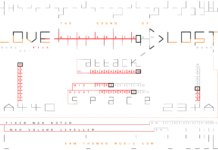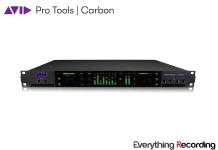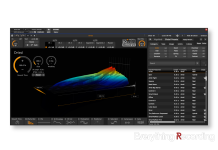Alright everyone, listen up. Everything Recording has a new addition to the team to help me with the reviews. Please welcome DC Patterson to the Everything Recording family.
DC is a location sound & music recordist, composer for film and television and produces albums for eclectic artists. He live on the far side of the planet in New Zealand.
I’m going to give the floor to him to review this extremely intuitive software synth package from u-he.
I play the “Atmosperherics” position in my band – lots of evolving pads, simple leads and massive impacts. Not surprisingly I use Spectrasonics Omnisphere (under Live8) for most of this, but along comes Zebra (www.u-he.com/cms/zebra) to make me see things differently. Zebra neatly covers the evolving pads and (not so) simple leads department. And it comes with 3 really tricked out extras that make this a great package. Straight up front I knew I had something I could play live. But if you are recording, and have the time, you’ve just stepped into a word where you can get a vast amount of sounds from one interface. I played more than I programmed, and I’m sure I’ll learn new stuff for a long time as I get deeper, but since I want you to try the darned thing for yourself, go to their website and get the demos – then play the heck out of it and have some fun.
To get us all started, I run over some of the features, and share some of my discoveries.
Zebra
Zebra 2 is a modular synthesis environment. That’s the easy part. Every one’s seen that whole wall of Hanz Zimmer’s studio covered in one modular…this is the software equivalent. In fact, It’s probably replaced it’s hardware forbear as you can hear Zebra on The Dark Knight, and a few of Mr.Zimmer’s (we are not worthy) recent scores. And a few other big time films too! Unlike the wall of wires, and so many synth programs, Zebra is easy to run, and even easy to mess about with under the hood. The UI is clean and friendly, and there are more skins to amp up the ‘friendly’. The modules are easy to connect and move and even understand.
Everything is made from scratch, so you are going to get more flexibility than a ‘sampler’ or even ‘sample based’ synthesis approach. I noticed right away that sounds moved about my headphones differently – because nothing is set in stone with Zebra. You can approach it in two ways…wait for it…black or white…(sorry): Preset whore (that’s me) your way through a bajillion interesting sounds…then use them as a basis for tweaking your way to your own patch.
Or…
You can watch all 47 easy to follow YouTube videos that take you through the functions and interactions of every module and effect (found HERE)
Part of Zebra 2’s charm is it’s quietly efficient visual interface. A bit like Propellerheads’ Reason in that you can move things around, and there is a reason to how thing work together, but it eclipses Reason in that the modules are all similar enough that you don’t get confused but an unnecessary clamor of multicolored boxes with the controls all in different places. And unlike some modular approaches, it’s not a scantily clad series of line diagrams either. Zebra gets the balance between modular and audio components right. The knobs are knobs and the displays are easy to interpret. Having said that, it’s still a powerful and deep piece of software. Preset wastrels beware, you may have to learn a couple of things to edit the patches. But, it won’t be as hard as many of the synths I’ve tried in the past.
And did I mention the 47 videos plus a large support base and user community? Make the effort and this might be the only synth of it’s kind you need (true at least for the 10% that really put the work in).
When you first open Zebra, you are in “Perform” mode. You get 4 x/y controllers (nice large ones) labeled with their basic function on top, and the specific function of the x and y positions in a (almost too) small type underneath. For example, a controller called “Character” on top had x + = Resonance and Y= waveform written underneath. These controllers are specific to the patch, and some patches use only one of the 4 controllers – the others being graphically obviously disabled – a great thing that stops you adjusting a control that’s not doing anything (we’ve all been there) and wondering why we don’t hear it.
3/4 Down you get a series of panels you move between to adjust oscillators and the apreggiator etc. There is also a patches window that lets you browse by category and has a simple view of the current patch’s modular layout. When you are in Synthesis mode you get to see how the sound is put together. Remember, these are just displays, you can keep playing and listening as you navigate around. In the center is the main grid that gives you an overview, the actual generators are on the left, and the modulators are on the right – check wikipedia if you don’t know what these do. It’s important, but won’t fit in the scope of this review.
You can adjust the size of Zebra’s interface, a complex patch with a few modules is going to be scrollable, and therefore the ingenious main grid shows you simply how everything fits together. Easy to read, and therefore easy to understand. I spent a few hours right away just playing with the fantastic sounds that came with the basic version. There is a very large community of users and plenty of places to get free and affordable add-on patches. The fact that anyone can use Zebra (not being limited by no access to original samples) to create patches from scratch in a way that more accessible to musicians (not just squirrels on meth and that guy that built the Karma Keyboard) means Zebra stands to be one very influential and diverse tools we’ve seen in a while. If you just make the effort to start editing even the presets, you’re on your way to creating new and rewarding sounds.
Zebralette
This is a reasonably simple oscillator ‘playground’ for quick playing and basic tinkering – but simple doesn’t mean boring. This is the caviar of simple. It’s small, just open the jar, but…Lot’s of delicious sounds are there for the tasting.
Right off the bat you get great lead instruments with the sort of Vangelis/ARP sweeping and evolving delirium. I love it! Many of them move in such a way that a single note sounds best in, for example, the low end, while chords function well in the highs. It has a lot to do with the timing of the motion being more organic – the lows move at a different time to the highs, but it all fits together. This is a vast improvement on many less able synths where playing a lower note simple changes the pitch. This is an instrument for Jarre fans, a lot of retro color, but melodic and graceful, rather than the ‘fork through your eye’ shriek of a lot of modern dance music textures some synths favor. If Omnisphere didn’t exist, and I still had my Roland XP30, I’d have given a nut or two to get a hold of Zebralette! And I would have cheerfully parted with the XP30 if I could swap.
In the middle of the interface is a window with a waveform displayed – a great start to understanding how the patch is going to behave. But it gets better – you can directly grab the waveform and jerk it around the place to edit the patch, and underne the display is a series of boxes with alternate waveforms displayed. Simply click one to get a new waveform. All of this works smoothly in real time without dropouts, clicks or any other coitus interuptus between you and the magic tones swelling through your brain. (I use headphones).
A lot of what I was hearing in the presets were not so much vintage (read old patches from previous products by many synth makers) but had a sort of extremely usable “old school’ vibe. Mellow but tasty leads. Pads that filled in a track nicely – all of it in that rare category of usable. So usable in fact that rather than trying to find a lick that suited the patch, I found the patches making it easier to sound out tasty licks. I think Ray Charles would have spent a week holed up with the El Piano (electric piano) patch driving it’s variations into new but elegant versions of itself, in turn bringing a fresh feel to even a simple riff.
You get 2 effects per patch on the bottom of the interface – the simple knobs are very easy to grab with the mouse and display their setting in ‘radar’ sweep inside the knob – a great graphically powerful way to display how far you’ve gone, and how much further you can push a parameter. Like an airplane – under the heat of performing live, or recording off the cuff, it’s vital you can find your way around the instrument(s) and while Zebralette is packed with (great useful) controls, it’s broken in to easy to spot regions that make sense. These are broken into Tune, FX, Phase, Waveform, & VCA. At the bottom of the instrument is a choice of modulation, effects, and a preset browser that has a nice set of categories to find that big bootie bass in a hurry.
At the very top is a u-he Zebralette nameplate that has a link to the company website embedded. The rest of the top is taken up with a simple back/forward preset changer (and if you click on the current patch it gives you a list of patches in that particular category). This is implemented more forgivingly than Native Instruments version where it’s easy to fall of the list. And finally, in the top right corner are some simple (but once again useful) specs: the number of voices, mode (such as polyphonic) and PB up down. If a control is unique to a patch, it says so – and if it’s disabled, it tells you. Once again, that saves years of twiddling a knob that’s going nowhere.
Many collections of preset patches seem to have the same tried and true (read tired) pure tones and noises. I didn’t find any in Zebralette’s arsenal. I never found myself skipping through a whole raft of “heard that before” bland offering. Kudos team for giving me a preset list that shows of the instrument without feeling like it has to prove anything by emulating other people’s sounds. A great example is JJ Fractalnation – a big juicy lead or brain smashing bass – I’ve heard big juicy bass notes like this, but Zebralette has a bit of organic motion that just pushes it over the top into “gotta play this loud ’till it hurts” territory.
Just after it is JJ Possible Implosion that has that same cheerfully grungy bass, but with motion and lively sparkle and reverb that just makes each note more than just a change of pitch. That sort of earthy individuality on each patch puts many hardware synths with their basic ROM patches sound very 1 dimensional in comparison.
Overall I found the sounds on Zebralette to be of a particular vintage tone, in the same way a Nuemann U47 has an ‘older sound’ that just makes us smile more than the newer stuff. Usable sounds, easy to edit and save your own, and a set of patches that you will be able to rely on for playing lead, and adding the odd mellow sprinkle to any song. I found the overall tone to be mellow, but it’s easy to crank open a filter or two for a little fork to the forehead action.
Zebrify
A quick to learn fx VST that uses the same 4 xy controllers as it’s synth namesake. Each preset has it’s own unique set of parameters that you run by flinging (or moving if you’ve had less caffeine) up, down, back and forth as you enjoy the righteous mangling and syrupy reverbs that you can of course design and implement at your whim. It has a Perform page which even a noob will figure out, but under the hood (via a series of pages switched to from the lower half of the display) is a very customizable and powerful effects engine. It’s easy enough to get started with great presets, but remember, when you have the time you can make the effects you want, then manipulate them and breath life and movement into your mix.
More fun than a Korg Kaoss and 2 XXL cans of Monster.
Zrev
A reverb with more buttons and knobs than Darth Vader’s bathroom. It has some wicked sounds, but I’ll have to write back in a week or two when I’ve mastered it. I quote the manual here by saying “The left section is a feedback delay network with damping, the right section is two cascades of nested allpass filters with adjustable feedback for each set.”
Feedback in audio is a powerful way to get frequencies tripping over themselves to articulate very elaborate tones and interactions. If you’ve ever envied the lead guitarist humping his axe in front of an amp, now you have a reverb that can do similar sonic rearrangements (less the performance histrionics guitars induce).
The manual poo poos a random approach to setting the jolly thing, then give you an email address to send your settings if you think you’ve nailed it. Think of it as the undiscovered country – great things are to be revealed if you don’t get eaten first.
In Conclusion
I don’t believe one synth can truly rule them all – as soon as you have two or more engines in the same instrument it’s going to get unwieldy – thus I decry and deride any synth that tries to do too much. Zebra just does it’s thing without fuss.
Zebra as a synth is wonderfully playable live. That’s something I don’t find with Reason or Reaktor on several counts. It’s powerful in ways only getting under the hood will unleash; and since it’s 100% synth, no samples (take that preset harpie sampler) you have 100% control and about 200% flexibility. I applaud the documentation and video training, it’s backed by a large community. What’s not to love? I can afford it, and I can play it live within 15 seconds of install. That’s cool.
It makes me sound good. That’s even cooler.
As with any real bit of programming, you are going to have to learn the basics and apply a bit of effort to get educated. With Zebra, this has so for been an easy and rewarding experience; but I can see it’s going to take time. If you are already familiar with modular thinking or programming, you’ll be up and running in no time. My limited skills from Reason were enough education to get me started. The rest of you card carrying “Got my Moog and my copy of Switched on Bach” nuts will be very happy campers.
The 3 other programs that came with Zebra are worth $100 on their own, so all in all a great sounding and great value deal – you should start selling blood now to buy it. Hey – that’s way less than the pair of kidneys the hardware version would have cost you for a fraction of the power.
Be the first to leave a review.














